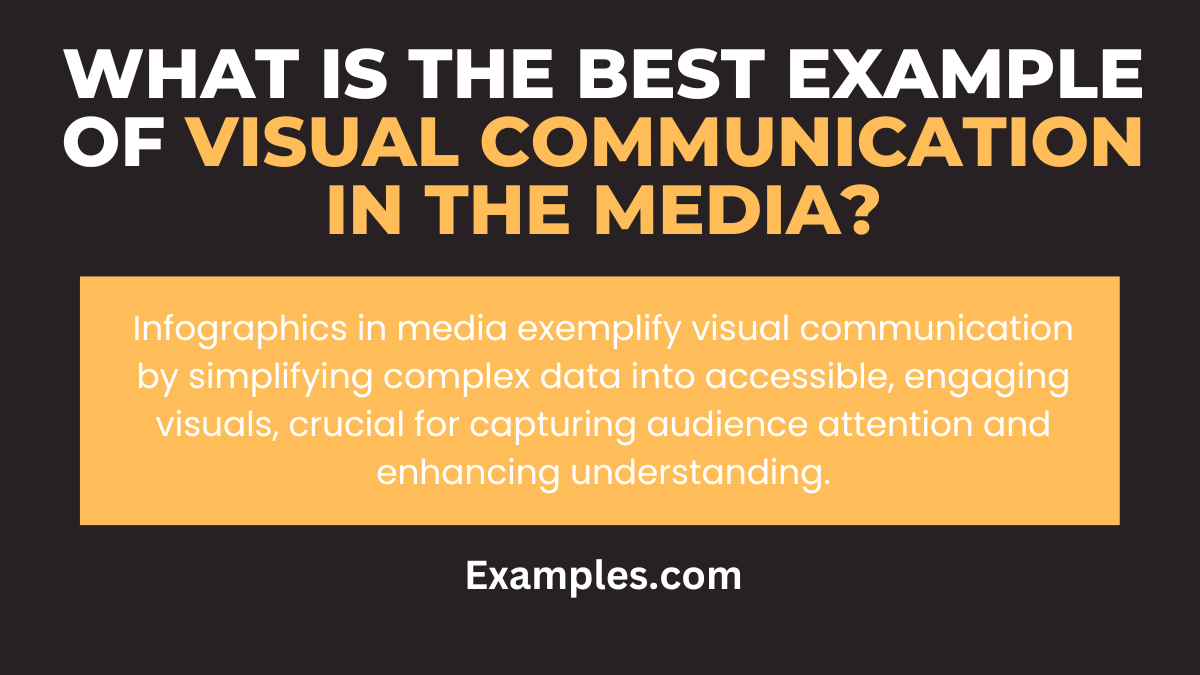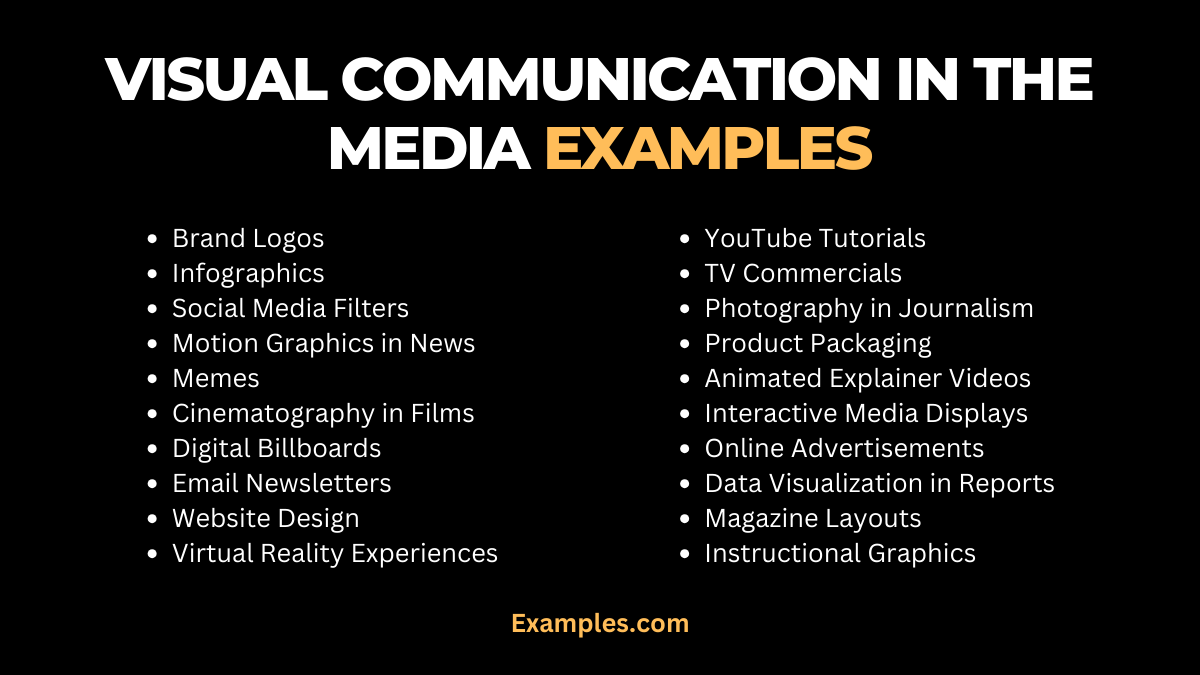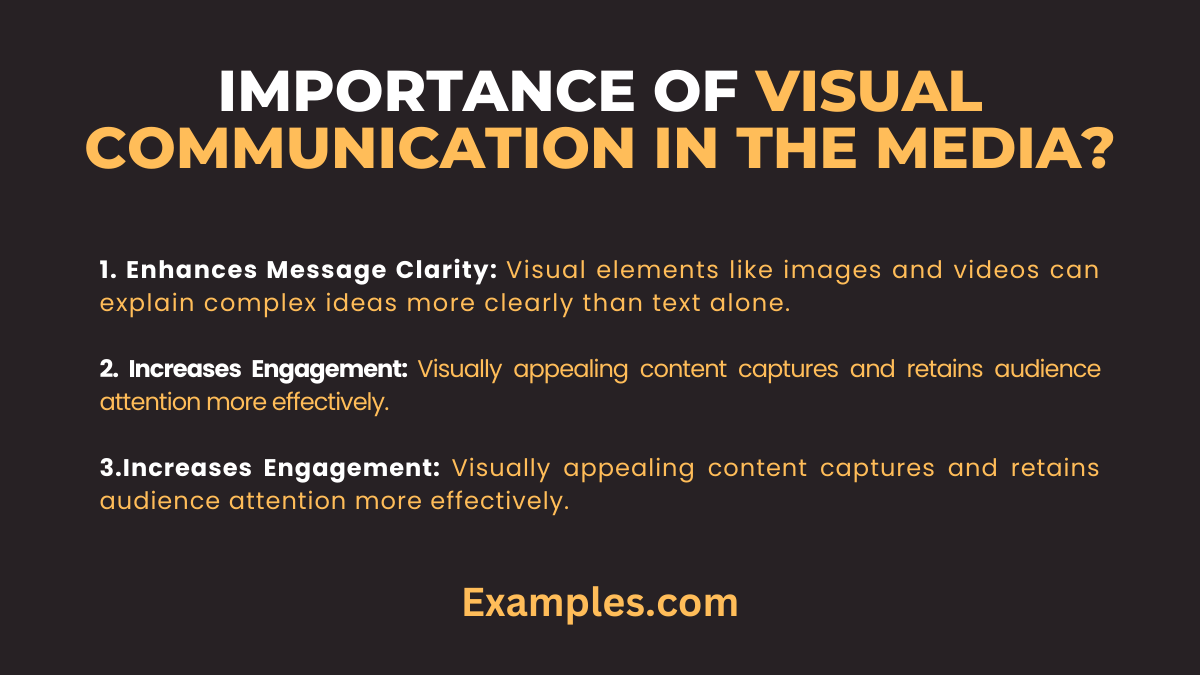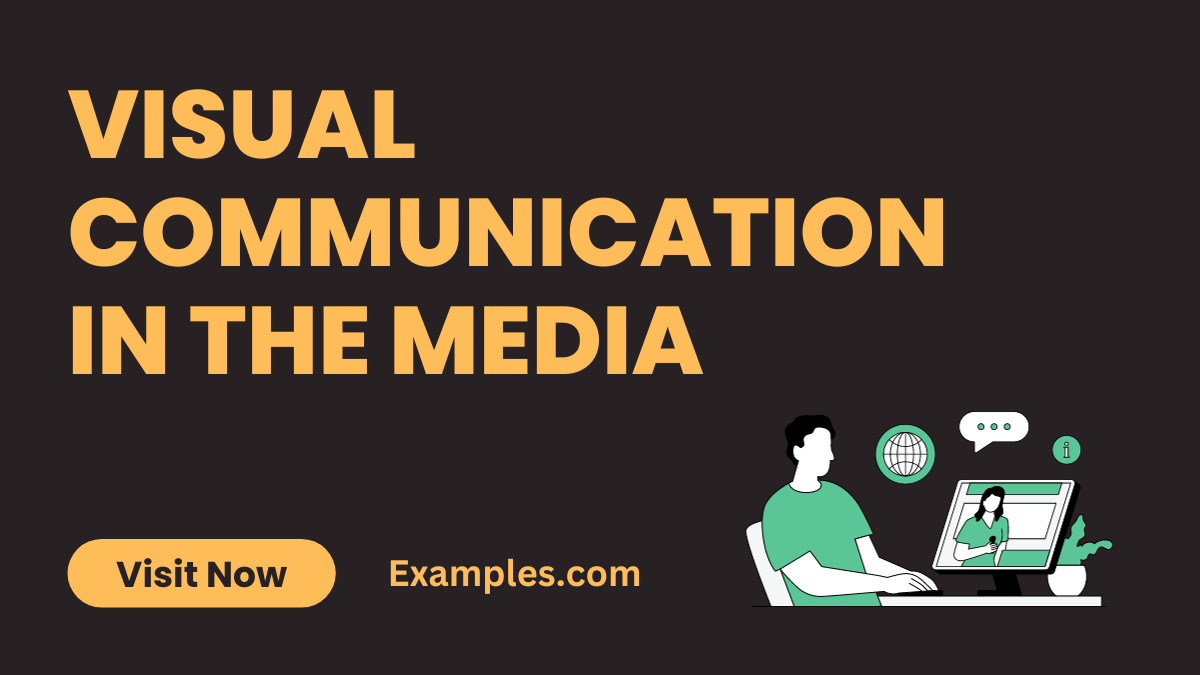19+ Visual Communication in the Media Examples
“Visual Communication in the Media: A Complete Guide with Examples” offers an in-depth exploration of how visual elements like images, videos, and graphics play a crucial role in media communication. This guide, brimming with communication examples, provides insights into the effectiveness of visual strategies in engaging audiences. It covers everything from graphic design trends to multimedia storytelling techniques, highlighting the power of visuals in capturing attention and conveying messages in today’s fast-paced digital world.
Download Importance of Visual Communication in the Media PDF
What is Visual Communication in the Media?

Visual communication in the media is the practice of using visual elements like pictures, videos, and graphics to share information and tell stories. This method is crucial in the media because it helps people understand and connect with content quickly and easily. It’s all about making messages more engaging and clear through visual art and design. Effective visual communication can include everything from using visual communication examples in news articles to employing graphic design trends in advertising, making it a versatile and powerful tool in the media landscape.
What is the Best Example of Visual Communication in the Media?

A prime example of visual communication in the media is the creation and use of infographics. Infographics are an excellent way to present complex information or data in a simple, visual format. They combine images, charts, and minimal text to make information more accessible and memorable. This is especially useful in digital marketing and online media, where capturing and holding the audience’s attention is vital. Infographics are a clear demonstration of how visual elements can enhance understanding and engagement, making them a standout choice for effective media communication.
20 Visual Communication in the Media Examples

“Discover 20 fascinating visual communication examples in the media, each showcasing the power and diversity of this vital communication form. From advertising to news, visual communication enriches our understanding and enhances engagement. This collection illustrates the importance of visual communication, revealing how it shapes our perception of information and stories in the digital age. These examples, ranging from classic to innovative, demonstrate the types of visual communication and their unique impact in the media landscape.”
- Brand Logos: Icons that visually represent a company’s identity.
- Infographics: Data and information presented in a graphical format.
- Social Media Filters: Augmented reality filters used in social media platforms.
- Motion Graphics in News: Animated graphics to explain news stories.
- Memes: Viral social media images conveying humor or commentary.
- Cinematography in Films: Visual storytelling through camera work in movies.
- Digital Billboards: Large-scale outdoor digital advertising displays.
- Email Newsletters: Visually engaging digital newsletters.
- Website Design: The visual layout and aesthetics of websites.
- Virtual Reality Experiences: Immersive, visually-driven VR content.
- YouTube Tutorials: Instructional videos using visual aids.
- TV Commercials: Short, visually compelling advertisements on television.
- Photography in Journalism: Powerful images capturing news events.
- Product Packaging: Visually appealing and informative packaging designs.
- Animated Explainer Videos: Cartoons or animations explaining concepts.
- Interactive Media Displays: Engaging, user-interactive digital installations.
- Online Advertisements: Visually striking ads on websites and apps.
- Data Visualization in Reports: Graphs and charts in digital reports.
- Magazine Layouts: The visual design of magazine pages.
- Instructional Graphics: Visual aids used in educational materials.
Each of these examples reflects a unique application of visual communication, underscoring its versatility and effectiveness in the media.
Importance of Visual Communication in the Media?

Visual communication plays an indispensable role in the media, impacting how information is conveyed and perceived. It’s not just about presenting data; it’s about making a connection with the audience. Here’s why visual communication is so vital:
- Enhances Message Clarity: Visual elements like images and videos can explain complex ideas more clearly than text alone.
- Increases Engagement: Visually appealing content captures and retains audience attention more effectively.
- Improves Memory Retention: People remember visual information better than text, making visual communication a powerful tool in media.
- Fosters Emotional Connection: Visuals can evoke emotions, making messages more impactful.
- Crosses Language Barriers: Images and symbols are universally understood, making visual communication an effective global tool.
The importance of visual communication in the media cannot be overstated. It’s a dynamic and evolving field, continually influenced by visual communication trends and technologies. By utilizing various types of visual communication, media professionals can create content that is not only informative but also deeply engaging.
How does Visual Communication Impact the Media?
Visual communication has a profound impact on the media, revolutionizing the way information is presented and consumed. Its influence is seen in various aspects of media, from news broadcasting to digital marketing. Here’s how:
- Enhances Message Clarity: Through visual communication examples, complex ideas are simplified, making them more accessible to a wider audience.
- Increases Engagement: Eye-catching visuals grab attention more effectively than text alone, leading to higher engagement rates.
- Improves Memory Retention: Visuals help audiences remember information longer, as demonstrated in various visual communication journals.
- Facilitates Emotional Connection: Images and videos can evoke emotions, creating a deeper connection with the audience.
- Supports Brand Identity: Through consistent visual elements like logos and color schemes, brands establish a strong visual identity.
- Drives Digital Interaction: Interactive elements in visual communication, like clickable infographics, enhance user experience.
- Cross-Cultural Communication: Visuals can transcend language barriers, making messages universally understandable.
- Adapts to New Technologies: Visual communication evolves with technology, from interactive media design to augmented reality experiences.
Visual communication, in its various forms and applications, plays an indispensable role in the media. It’s not just about what is shown, but how it’s shown. This guide underscores the importance of visual communication and its ability to transform media into a more dynamic, effective, and inclusive platform.
How is Visual Communication Used in Social Media?
In the realm of social media, visual communication is a key player. It’s the art of conveying messages and ideas using visual elements like images, videos, graphics, and animations. Social media platforms are visual by nature, and understanding how to leverage this form of communication can significantly enhance engagement and message clarity.
- Images and Photos: Platforms like Instagram and Pinterest thrive on photo sharing. High-quality, captivating images are used to grab attention, tell stories, and evoke emotions.
- Videos: Video content, including live streaming on platforms like Facebook and YouTube, offers a dynamic way to engage audiences. It’s a powerful tool for storytelling, demonstrating visual communication skills.
- Infographics: These are especially popular on platforms like LinkedIn, where complex data or information needs to be conveyed succinctly and engagingly.
- Emojis and Stickers: Often underestimated, these small visual elements add tone and emotion to textual content, enhancing the visual communication in the media.
- GIFs and Memes: These forms of visual content are prevalent across all social media platforms for their ability to convey messages humorously and relatably.
- Augmented Reality (AR) Filters: Snapchat and Instagram use AR filters, showcasing the importance of visual communication in creating interactive and immersive experiences.
- Storytelling through Visuals: Platforms like TikTok and Instagram Stories utilize quick, engaging visual narratives to share experiences and information.
- Brand Visual Identity: Social media provides a platform for brands to establish a consistent visual identity, crucial for brand recognition and loyalty.
How Does Visual Media Help to Gain Attention to Viewers?
Visual media captures viewers’ attention through engaging imagery, vibrant colors, and dynamic content, making messages more memorable and impactful in the media landscape.
How Effective is Visual Media?
Visual media is highly effective due to its ability to convey complex information quickly, evoke emotional responses, and enhance message retention among diverse audiences.
How Does Media Affect Communication?
Media transforms communication by offering varied platforms for sharing information, influencing public opinion, and shaping cultural norms through both textual and visual content.
In conclusion, this article on “Visual Communication in the Media” illustrates through varied examples how visuals profoundly impact media communication. From infographics to multimedia storytelling, these examples demonstrate the power of visuals in conveying complex messages in an engaging, clear, and effective manner, highlighting the indispensable role of visual communication in today’s media-driven world.
The article on Examples.com provides an insightful overview of visual communication in the media, detailing how it’s used and its significant impact. To enhance your understanding further, exploring educational programs that focus on visual communication can be beneficial. Texas A&M University-Commerce offers a Bachelor of Fine Arts in Visual Communication-New Media, providing in-depth knowledge in this field. For a scientific perspective on the psychological impact of visual communication, the study published in Frontiers in Psychology, available at Frontiersin.org, offers valuable insights. These resources can enrich your understanding of the power and nuances of visual communication in media.



